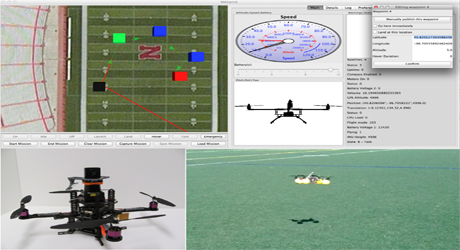
The Department of Computer Science and Engineering's Innovation Lab will hold a showcase of senior design projects, 4 to 6 p.m. today on the second floor of the Schorr Center. The event is free and open to the public. Refreshments will be provided.
Students enrolled in Computer Science and Engineering's senior design course developed the projects this semester. Each project was sponsored by a company or UNL faculty member. The course is taught by Computer Science and Engineering faculty Sharad Seth and Mehmet Can Vuran.
Eight groups will demonstrate projects. Group names, sponsorships and explanations of the projects are:
Maverick
— Sponsored by Sebastian Elbaum and UNL's Nimbus Lab
This is an intuitive and interactive user environment for Micro Air Vehicles (MAV's) that allow users to visualize, control, and automate MAV's without an internet connection. Learn more at http://go.unl.edu/mrs.
GeoBee
— Sponsored by Nebraska Global
The GeoBee software application provides users with a graphical tool to visualize and edit geospatial data. This product is intended as an alternative to current geographical editing solutions that have a considerable learning curve to use and require training or specialization.
E-Snow Road
— Sponsored by Ian Cottingham, Can Vuran, Red Brain Inc. and CPN Lab
Snowplow Tracker is a system designed to enhance the efficiency of snow removal operation. Using specially designed hardware, a cellular network, and an easy-to-understand user interface, the Snowplow Tracker is able to deliver a unique solution for managing a city or county's snow removal assets. Learn more at http://go.unl.edu/7ts.
Feather Rufflers
— Sponsored by Joseph Fontaine, Can Vuran, and CPN Lab
The goal of this project is to create a device that will allow the tracking of pheasants through GPS that will attach in the form of a collar. The data that is collect will be GPS coordinates with timestamps and will need to be collected via base stations positioned along the perimeter around the target field. Learn more at http://go.unl.edu/hdj.
Terrestoria
— Sponsored by Paul Kenyon
The Tabulation of Medical Codes and Terminology (TOMCAT) is a database system and web front-end that allows a user to encode and decode medical information from a mobile device, with the interface optimized for mobile use. Its objective is to expedite searches for these terms by allowing a mobile method of access to these medical datasets. Learn more at http://go.unl.edu/4ay.
Kinect Force One
— Sponsored by Anita Sarma and IDC Lab
This painting application allows users to create artwork using gestural abstraction in which paint is spontaneously dribbled, splashed or smeared onto the canvas, rather than being carefully applied. The implementation of the paint application uses touch-free technology (via the Kinect). Learn more at http://go.unl.edu/2ge.
Forest Dragons
— Sponsored by students involved
The Kinect wall is a dynamic display system that consolidates the features of a rooms electronic devices and provides a single intuitive user input method for system control. The systems audio/video features negate the need for a T.V. and radio by providing Audio/Video playback from file and Broadcast T.V./Radio playback. Learn more at http://go.unl.edu/8j5.
aMaze
— Sponsored by David Swanson and Holland Computing Center
The Holland Computing Center has more then 1500 nodes distributed over five supercomputing clusters. The hardware that provides the processing power that these nodes run on has a high performance demand and needs constant supervision and maintenance to keep up and running. This supervision is facilitated by feeds of health and load server statistics, which provide relevant data about the state of each server at HCC. Given these data feeds, we aim to produce a program that can report information about the state of all the servers. We propose a web-based wireframe and 3D visualization environment for health and load statistics of the HCC servers. Learn more at http://go.unl.edu/sdt.